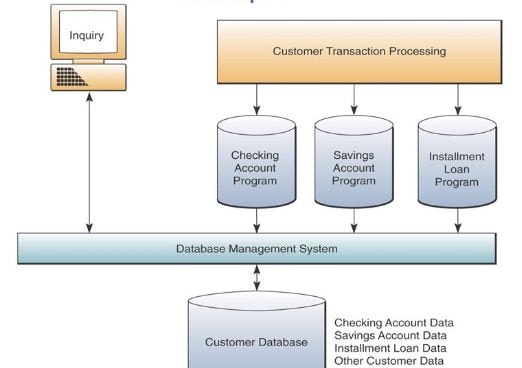Database Approach Advantages & Dis-Advantages
Table of Contents
The database approach is a technique of sharing data among different users simultaneously. The user can also interact with DBMS with the help of the front end. For further detail, read the topic completely.
Database Approach
The database is the most important asset of an organization. The database approach provides the facility for data sharing. Many programs and users can share the same data in the database for different purposes. For example, a database that stores the data of students can also be used by Library Management Program, etc.

The data in the database can be accessed by using a database management system. The user can also interact with DBMS with the help of the front end. The front end is a program that has a more user-friendly interface than DBMS.
Read More:
- Types of Information Systems With Applications
- Types of Data Processing With Examples
- Pokemon Omega Ruby 3DS ROM Download
- OnionPlay APK v9.8 For Android & iOS
In this case, the DBMS works as a back-end application. The user interacts with the front end and the front end application interacts with the back-end application.
Advantages of Database Approach
Some important advantages of the database approach are as follows:
Redundancy Control
The data in a database appears only once and is not duplicated. For example, the data of a student in a college database is stored in one table. We can access this table for different purposes. For example, if we want to store the marks of the student in a table, only Roll No of the student will be used.
The second table will be connected to the student table for accessing the information about the student as follows:
Student Table
|
Roll No |
Name | Address |
Phone |
|
| 1 | Usman | Faisalabad | [email protected] | 067-665774 |
| 2 | Abdullah | Lahore | [email protected] | 051-678488 |
|
Roll No |
Subject |
Marks |
| 1 | Math | 88 |
| 1 | English | 78 |
| 2 | Math | 98 |
| 2 | English | 75 |
In the above figure, the details of the students are stored in the Student table. The Marks table stores only the Roll No of the student. The remaining data is not duplicated. Roll No in the Marks table is duplicated for joining two tables.
Consistency Constraints
Consistency constraints are the foundations that have got to be followed to enter knowledge within the information. If the information doesn’t fulfill these constraints, it can’t be entered within the information.
Management systems also give a simple approach for applying completely different consistency constraints that make sure the consistency of the info in databases. whereas in a standard filing system, it’s troublesome to enforce such conditions.
As an example, the balance of a checking account could ne’er fall below a prescribed quantity.
Data Atomicity
A collection of all steps needed to finish a method is referred to as dealing. The atomicity implies that either one dealing ought to come about as an entire or it mustn’t come about in the least.
It also ensures that the information can perpetually have correct and consistent knowledge. Suppose you would like to transfer cash from account A to account B. This method consists of 2 steps:
- Detect the cash from account A.
- Add the cash to account B.
Suppose the system fails once the laptop has performed the primary step. It implies that the number has been subtracted from account A, however, it has not been more to account B. things will build the info inconsistent. The software package doesn’t enable such a scenario to happen.
The management system either executes each step or doesn’t execute any step.
Data Security
Data security is the protection of knowledge from unauthorized access. The management system provides several procedures to require care of knowledge security. The protection is maintained by allowing access to knowledge through the use of passwords.
Not every use of the knowledge system has to be compelled to be able to access all the information. In some things, you may like to produce different types of access permission to info for numerous users. As an example, a data entry operator has to be compelled to exclusively be allowed to enter data.
The chairman of the organization has to be compelled to be able to access or delete the information totally. The management system also provides entirely completely different levels of security decisions for numerous users.
Reduced Development Time
A piece of information organizes info extra expeditiously than a file method system. It’s generally easier and faster to develop programs that use this info. Many management systems to boot provide several tools to assist in program development. So it reduces the final time for developing applications.
Compactness
The management system stores data with compactness and efficiency. It needs less cupboard space than the classification system. Therefore it saves the storage resources of the system and memory isn’t wasted.
Easier Reportage
Reports area unit vital a part of info applications. This area unit is terribly essential for taking crucial selections concerning a corporation. The information within the database is held in an associate degree organized manner. It will simply be retrieved for making completely different reports.
The reports are ready simply and quickly within the needed format in a database management system.
Data Sharing
Once the info is developed, it is employed by many users within the organization. The info can even be shared by completely different applications. If a brand new application needs similar knowledge, it will share the present info rather than developing it once more.
Increased Concurrency
Sometimes, 2 or a lot of users could access a similar file at the same time. These accesses could interfere with one another. This might end in loss of knowledge or maybe a loss of integrity. Several database management systems manage coincidental access and guarantee such issues cannot occur.
Improved Backup and Recovery
In file primarily based systems, it’s the responsibility of the user to shield knowledge from failures of the pc system or application. This might need to take a backup of the information daily. Furthermore, If the information is lost, the backup is fixed up.
The fashionable software package offer facilities to reduce the quantity of process that may be lost because of a failure.
Data Independence
The database approach provides the power of information independence. It also implies that the information and also the application programs square measure become independent from one another. you’ll modification information storage structures and operations while not dynamic the applying programs.
Disadvantages of Database Approach
Some of the disadvantages of the database approach are as follows:
The high price of the software package
An entire management system is an incredibly massive and complicated software package. It’s costly to buy a management software package.
Higher Programming Price
DBMS is a complicated software package with several options. The programmers would like intensive information on the system to use it to their best advantage. Furthermore, If the organization hires intimate info programmers, it’s to pay an additional price for this experience.
Higher Hardware Price
Database management system square measure difficult and significant software package. Extra memory and processor power could also be needed to run the software package. It’s going to need additional powerful hardware.
High Conversion Price
If a corporation converts its records to a management system, information must be reborn from files to the info. It’s going to be a tough and time intense method because of totally different formats employed by different systems.
Moreover, the structure and information may additionally have to be compelled to be changed in step with the wants of the management system.
More Chance of Failure
In the management system, all resources and parts square measure centralized. If any of those parts fails, the entire system stops.
Complexity & Performance
The database management system is a general-purpose software package. an entire software package must perform several tasks that build it complicated and complex software packages. In some applications, software packages might run less expeditiously as compared to the file process system.
Important Links:
| 4 Types of Optical Disks | Process & Process Control Block | 3 Types of Mainframe Systems |
| 3 Types of Data Processing | 7 Types of Information Systems | What is Printer & Its Types |


